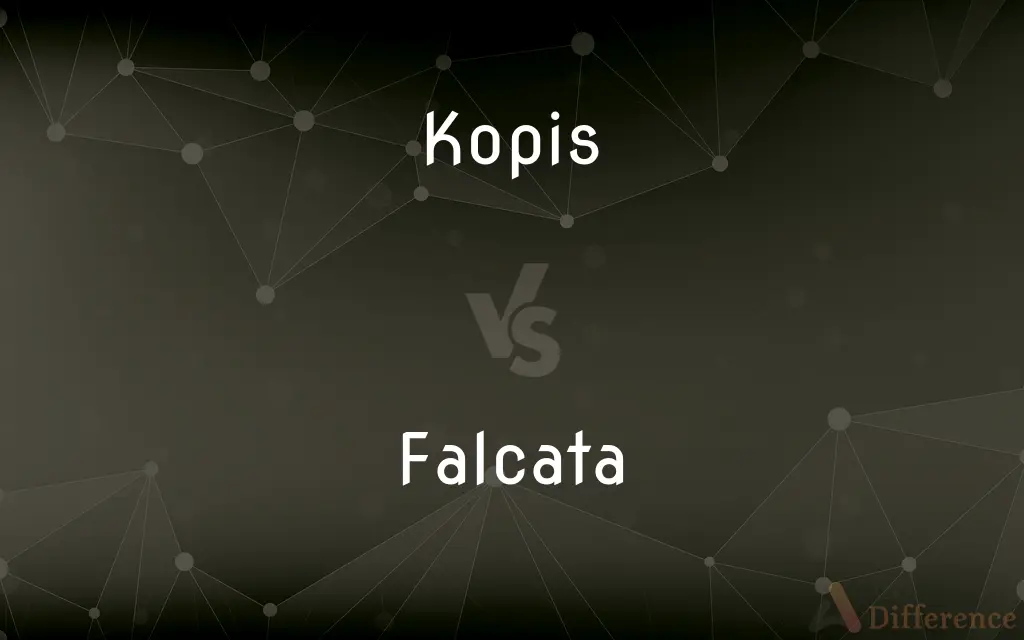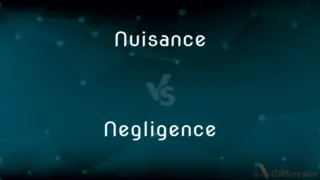Kopis vs. Falcata — What's the Difference?
By Tayyaba Rehman — Updated on October 30, 2023
The Kopis and Falcata are both ancient single-edged swords, with the Kopis hailing from Greece and the Falcata originating in the Iberian Peninsula, distinctive for its curved blade.

Difference Between Kopis and Falcata
Table of Contents
ADVERTISEMENT
Key Differences
Kopis is a type of ancient Greek sword characterized by its forward-curving blade. It was a single-edged sword used primarily for chopping and slashing. The design of the kopis made it effective for both cutting and thrusting motions, making it a versatile weapon in ancient warfare.
Falcata, on the other hand, is a sword that originated in the Iberian Peninsula. It is also a single-edged weapon, but it is distinguished by its inward-curving blade and its unique handle design, often featuring a hook-like shape. The falcata was known for its exceptional cutting power, attributed to its distinctive blade shape.
In design, the kopis has a blade that curves forward, making it similar in appearance to a machete. This design feature gave the kopis a powerful chopping ability, making it effective against armor and shields. The kopis was often used by Greek cavalry and infantry alike.
The falcata not only had a curved blade but also often featured a handle with an anthropomorphic or zoomorphic design, reflecting the artistic culture of the Iberian people. The falcata's design made it especially effective for slashing, and it was highly prized for its craftsmanship and effectiveness in battle.
Historically, the kopis was one of the preferred weapons of the ancient Greeks, including the famous general Alexander the Great. Its design influenced other sword types in the Mediterranean region.
ADVERTISEMENT
The falcata was widely used by Iberian warriors and was also adopted by some Roman soldiers. The falcata's design influenced the development of other swords in the Roman world and beyond.
Comparison Chart
Origin
Ancient Greece
Iberian Peninsula
Blade Shape
Forward-curving
Inward-curving
Edge
Single-edged
Single-edged
Handle Design
Simple, functional
Often ornate, with unique shapes
Use and Effectiveness
Effective for chopping, thrusting
Exceptional for slashing
Compare with Definitions
Kopis
Ancient Greek sword
The soldier wielded a kopis with skill.
Falcata
Ancient Iberian sword
The warrior's falcata was a symbol of his prowess.
Kopis
Single-edged weapon
The kopis' single edge was razor-sharp.
Falcata
Handle with unique design
The falcata's handle was intricately carved.
Kopis
Used in ancient warfare
The kopis was a common sight on ancient Greek battlefields.
Falcata
Influenced sword designs
The design of the falcata influenced later swordsmiths.
Kopis
Forward-curving blade
The forward curve of the kopis made it ideal for slashing.
Falcata
Single-edged with a curved blade
The falcata's curved blade was effective in close combat.
Kopis
Versatile combat sword
The versatility of the kopis made it a preferred weapon.
Falcata
Renowned for cutting power
The falcata was feared for its cutting ability.
Kopis
The term kopis (Ancient Greek: Κόπις) in Ancient Greece could describe a heavy knife with a forward-curving blade, primarily used as a tool for cutting meat, for ritual slaughter and animal sacrifice, or refer to a single edged cutting or "cut and thrust" sword with a similarly shaped blade.
Falcata
The falcata is a type of sword typical of pre-Roman Iberia. The falcata was used to great effect for warfare in the ancient Iberian peninsula, and is firmly associated with the southern Iberian tribes, among other ancient peoples of Hispania.
Kopis
A short forward curved sword in Ancient Greece used primarily as a cutting tool, but also for combat.
Falcata
(historical) A sword in pre-Roman Iberia having a concave edge to the blade.
Common Curiosities
Were both kopis and falcata single-edged?
Yes, both were single-edged swords.
What era did the kopis originate?
The kopis originated in ancient Greece, around the 6th century BCE.
Is the falcata blade always inward-curving?
Yes, the falcata is characterized by its inward-curving blade.
Did the falcata have a standard handle design?
No, the falcata often had unique, sometimes elaborate, handle designs.
Was Alexander the Great associated with the kopis?
Yes, Alexander the Great is often depicted with a kopis.
Is the falcata exclusively Iberian?
Yes, the falcata is specifically linked to the Iberian Peninsula.
Was the kopis used by infantry or cavalry?
The kopis was used by both Greek infantry and cavalry.
Did the Romans use the falcata?
Some Roman soldiers adopted the falcata, impressed by its effectiveness.
Were falcatas decorative or purely functional?
They were both functional and often decorative, especially the handle.
Was the falcata used in rituals or ceremonies?
Some evidence suggests the falcata had ceremonial uses.
Is the kopis similar to a machete?
In appearance and chopping ability, the kopis is somewhat similar to a machete.
Are kopis and falcata swords still made today?
They are made as replicas for collectors and historical enthusiasts.
Can the kopis be used for thrusting?
Yes, the kopis design allowed for both chopping and thrusting.
Did the kopis influence other sword designs?
Yes, the kopis influenced other Mediterranean sword designs.
Are replicas of the falcata and kopis accurate?
Quality varies, but some replicas are made with historical accuracy in mind.
Share Your Discovery

Previous Comparison
Amlodipine vs. Carvedilol
Next Comparison
Nuisance vs. NegligenceAuthor Spotlight
Written by
Tayyaba RehmanTayyaba Rehman is a distinguished writer, currently serving as a primary contributor to askdifference.com. As a researcher in semantics and etymology, Tayyaba's passion for the complexity of languages and their distinctions has found a perfect home on the platform. Tayyaba delves into the intricacies of language, distinguishing between commonly confused words and phrases, thereby providing clarity for readers worldwide.
















































